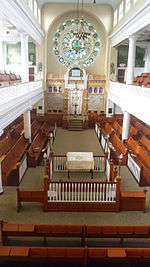Historic Congregation B'nai Abraham
| Historic Congregation B’nai Abraham | |
|---|---|
|
| |
| Basic information | |
| Location |
523-527 Lombard Street Philadelphia, Pennsylvania |
| Geographic coordinates | 39°56′35″N 75°09′05″W / 39.94319369999999°N 75.151253°WCoordinates: 39°56′35″N 75°09′05″W / 39.94319369999999°N 75.151253°W |
| Affiliation | Jewish |
| Rite | Ashkenaz |
| Year consecrated | 1910 |
| Status | Active |
| Leadership | David Mink, President |
| Website | phillyshul.com |
| Architectural description | |
| Architect(s) | Charles W. Bolton & Sons |
| Architectural style | Byzantine Revival |
| General contractor | Saml. Lashner & Co. |
| Groundbreaking | 1909 |
| Completed | 1910 |
| Construction cost | $28,000 |
| Specifications | |
| Direction of façade | South |
| Capacity | 1,000 |
Historic Congregation B’nai Abraham is a synagogue located in the Society Hill section of Center City Philadelphia. It is an active congregation with daily, Shabbat, and holy day services. B'nai Abraham is home to a Jewish Preschool,[1] as well as Lubavitch of Center City.[2]
Congregation

B'nai Abraham was established in 1874 as the "Russian shul". Its congregants officially incorporated in 1882 as Chevra B’nai Avrohom Mi Russe. An 1881 almanac identifies the name as Beth Hamedrosh Hagadol B'nai Abraham Anshe Russe. The synagogue would continue to be known as B'nai Abraham Anshe Russa; Congregation B’nai Abraham; the B’nai Abraham Congregation; and later as Historic Congregation B’nai Abraham.
Rabbi Israel M. Sacks served as first official rabbi of the congregation as early as 1881.[3] Rabbi Eliazar Kleinberg, Chief Rabbi of Vilna, assumed the pulpit of the congregation in 1889 and served for two years before his passing.[4] In September 1891, Rabbi Kleinberg was succeeded by his son-in-law, R. Bernard L. Levinthal. Rabbi Levinthal would serve as the congregation rabbi until his passing on September 23, 1952.[5] Rabbi H. Zvi Gottesman succeeded R. Levinthal on a part-time basis in 1954.
Rabbi Yochonon Goldman became the congregation's rabbi in 2000 and continues to serve in this capacity in 2015.
B'nai Abraham had 225 members and 150 seat holders in 1900.[6] The congregation had 75 members in 2011.[7]
Building
.png)
The B'nai Abraham building is 521-527 Lombard Street and shares the city block with Mother Bethel A.M.E. Church, 419 South Sixth Street. The original building on the site of 521 Lombard Street was the Wesley Church, an AME Zion congregation, completed and dedicated in 1820 by a group of African-American worshippers who had broken away from Mother Bethel. By 1885, Wesley Church's congregation had outgrown the building, moved west of Broad Street, and sold the building to Congregation B'nai Abraham [8] for $3,000. The dedication of the synagogue building was attended by Marcus Jastrow, rabbi of the city's German congregation, and Sabato Morais, rabbi of the Spanish and Portuguese congregation.
In 1909, B'nai Abraham retained the services of contractor Samuel Lashner & Co. to construct a new building at a cost of $28,000.[9] It was designed by architect Charles W. Bolton & Co. in the style of Byzantine Revival. Bolton and his firm had designed B'nai Reuben, built on South Sixth Street in 1905. They took as inspiration for B'nai Abraham's new building the Pike Street Synagogue (Congregation Sons of Israel Kalwarie) built in 1903 and 1904 at 13-15 Pike Street in Manhattan, and designed by the architect Alfred E. Badt. Demolition of the old building began on May 10, 1909[10] and the new building was dedicated April 1910.
521-527 Lombard is the oldest Philadelphia synagogue built as a synagogue and still in continuous use as such.[11]
References
- ↑ Holmes, Kristin E. (September 26, 2014). "Opening the doors to Jewish life to a new generation". Philadelphia Inquirer. Retrieved 2015-04-07.
- ↑ "Lubavitch of Center City". chabad.org. Retrieved 2015-04-06.
- ↑ Public Ledger Almanac. G.W. Childs. 1881. p. 32. Retrieved 2015-04-06.
- ↑ Friedman, Murray (1993). When Philadelphia was the capital of Jewish America. Balch Institute Pres. p. 128.
- ↑ Sherbock, Dan (March 10, 2006). Dictionary of Jewish Biography. A&C Black.
- ↑ Adler, Cyrus; Szold, Henrietta (1900). American Jewish Year Book. American Jewish Committee. p. 428.
|access-date=requires|url=(help) - ↑ O'Reilly, David (October 7, 2011). "Philadelphia's oldest synagogue thriving with hope". Philadelphia Inquirer. Retrieved 2015-04-06.
- ↑ "B'nai Abraham Synagogue". philaplace.org. Retrieved 2015-04-06.
- ↑ Mehren, Edward J.; Coddington, Henry; Goodell, John M. (1909). "Engineering Record, Building Record and Sanitary Engineer". 59. McGraw Publishing Company: 672.
- ↑ Boonin, Harry Davidow (1999). The Jewish Quarter of Philadelphia: A History and Guide, 1881-1930. Jewish Walking Tours of Philadelphia. ISBN 096698840X.
- ↑ "HISTORY". Historic Congregation B'nai Abraham. Retrieved 2016-12-27.